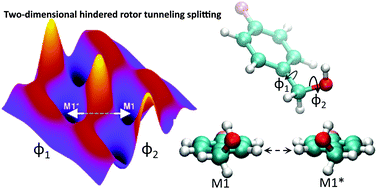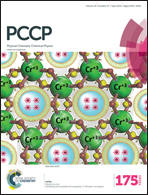Hindered rotor tunneling splittings: an application of the two-dimensional non-separable method to benzyl alcohol and two of its fluorine derivatives†
Abstract
In this work we present a novel application of the two-dimensional non-separable (2D-NS) method to the calculation of torsional tunneling splittings in systems with two hindered internal rotors. This method could be considered an extension of one-dimensional methods for the case of compounds with two tops. The 2D-NS method includes coupling between torsions in the kinetic and potential energy. Specifically, it has been applied to benzyl alcohol (BA) and two of its fluorine derivatives: 3-fluorobenzyl alcohol (3FBA) and 4-fluorobenzyl alcohol (4FBA). These molecules present two torsions, i.e., about the –CH2OH (ϕ1) and –OH (ϕ2) groups. The electronic structure calculations to build the two-dimensional torsional potential energy surface were performed at the DF-LMP2-F12//DF-LMP2/cc-pVQZ level of theory. For BA and 4FBA the calculated ground-state vibrational level splittings are 429 and 453 MHz, respectively, in good agreement with the experimental values of 337.10 and 492.82 MHz, respectively. In these two cases there are four equivalent wells and the tunneling splitting is the result of transitions between the two closer minima along ϕ1. The analysis of the wavefunctions, as well as the previous experimental work on the system, supports this conclusion. For 3FBA the observed ground-state splitting is 0.82 MHz, whereas in this case the calculated value amounts only to 0.02 MHz. The 2D-NS method, through the analysis of the wavefunctions, shows that this tiny tunneling splitting occurs between the two most stable minima of the potential energy surface. Additionally, we predict that the first vibrationally excited tunneling splitting will also be small and exclusively due to the interconversion between the second lowest minima.


 Please wait while we load your content...
Please wait while we load your content...